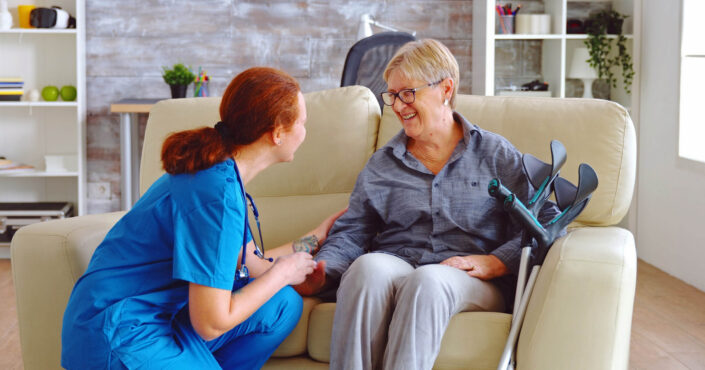As a healthcare professional, you meet patients of all ages and backgrounds. Some of those patients have limited ability for self-care which can make it more difficult for them to live independently. Part of your job is to conduct a thorough assessment and develop a care plan that includes appropriate nursing interventions for each deficit. This guide provides more details about these interventions.
Key Definitions
Whether you’re a new grad, an experienced staff nurse or regularly work travel nurse jobs, it’s important to review key definitions before diving into a discussion on nursing interventions for self-care deficits. Some of those definitions include the following:
- Self-care deficit: Patients with self-care deficits have difficulty performing certain tasks related to their health and well-being. For example, patients may have difficulty holding utensils while eating or performing basic grooming activities.
- Activities of daily living (ADLs): The medical abbreviation ADL refers to the tasks involved in a patient’s personal care. Bathing, dressing, eating, toileting and grooming are some essential ADLs.
- Nursing interventions: An intervention is an action you take to implement a patient’s care plan. Monitoring vital signs, administering medications and providing treatments are common nursing interventions.
Causes of Self-Care Deficits
Self-care deficits occur for several reasons. In some cases, they’re temporary. A patient who just had surgery may need help ambulating, but only until they recover from their procedure. Self-care deficits also develop due to chronic illnesses, age-related changes, mental health issues and serious injuries that have lasting effects.
Neurological Disorders
For people without self-care deficits, ADLs require minimal effort. When you brush your teeth or shower, you probably don’t even think about all the little steps involved in performing each task. Many neurological disorders interfere with the ability to perform specific movements, making it challenging to perform ADLs without assistance.
Brushing your teeth takes just a minute or two, but it requires good coordination. You must be able to hold the toothbrush in one hand and use the other hand to squeeze the tube of toothpaste. Then you must lift your arm to your mouth and have enough strength to move the brush around. Neurological disorders can cause muscle weakness, neuropathy and other problems that make it difficult to perform these small movements.
In older patients, Alzheimer’s disease and other forms of dementia are among the most common causes of self-care deficits. Patients with Alzheimer’s typically need help with ADLs once they’ve reached the fifth stage of the disease. Self-care deficits also occur due to Parkinson’s disease, cerebral palsy, amyotrophic lateral sclerosis and other neurological conditions.
Age-Related Mobility Issues

The aging process causes several physical changes, including loss of muscle strength and reduced bone density. These changes may affect balance, coordination and fine motor skills, making it more difficult for older adults to perform the ADLs they’ve been doing their whole lives.
Mental Health Issues
Depression and other mental health conditions affect motivation and may interfere with a patient’s ability to perform ADLs without assistance. In patients with substance use disorders, self-care deficits may develop due to a combination of physical and psychological factors. For example, a patient with alcohol use disorder may have difficulty bathing due to the poor coordination associated with intoxication.
Serious Injuries
Following an auto accident or other type of physical trauma, it may be difficult to perform ADLs due to reduced energy and stamina. Patients with serious injuries may have to plan their activities carefully based on when they have the most energy. They may also have to pace themselves to prolong stamina.
Some injuries are so severe that they result in quadriplegia, paraplegia and other lifelong conditions. Patients with these issues may need daily assistance from a family caregiver or home health aide to maintain their overall well-being.
Psychological Impact of Self-Care Deficits
While providing patient care, especially those working in skilled nursing facilities or home health nurse jobs, it’s important to be aware of the psychological impacts of self-care deficits. Orem’s self-care deficit theory highlights the importance of “self-care agency,” or a patient’s ability to practice self-care. When individuals don’t have that agency, they may feel depressed, frustrated or angry. Orem also focused on the importance of supporting patients and promoting personal development. Understanding the psychological impact of self-care deficits helps healthcare professionals carry out these essential activities.
Assessing and Addressing Self-Care Deficits
Healthcare professionals play a critical role in identifying self-care deficits and performing appropriate interventions. If you’re a nurse, going through the five steps of the nursing process can help you deliver the best care. These steps include the following:
1. Assessment
During your assessment, it’s important to collect social and psychological data in addition to information about the patient’s physical condition. Assessments provide an ideal time to evaluate the patient’s ability to perform ADLs and determine if they’re feeling angry, frustrated, overwhelmed or depressed by any limitations.
When assessing self-care needs, consider the patient’s home environment, transportation options, substance use, memory and social support. Some questions you can ask to identify self-care deficits include:
- Do you live alone, with a family member or with a roommate?
- Do you have a driver’s license?
- Do you have someone who can drive you to medical offices, grocery stores and other important places?
- Is there anyone who can assist you with bathing, getting dressed or other ADLs?
- Do you have running water?
- Is there a neighbor you trust to help you in an emergency?
Some of these questions may seem a little basic, but you can’t assume that a patient has a safe living environment with plenty of support available. Individuals with substance use disorders, limited financial resources and certain mental health conditions may be unable to maintain working utilities, shop for nutritious foods or form positive relationships with people willing to assist them with ADLs.
2. Diagnosis
Nursing professionals in travel and staff nursing jobs use their clinical judgment to diagnose existing problems and identify the potential for problems to develop later. Again, it’s vital to think about more than just pain and other physical symptoms. Your diagnosis may include social challenges, family problems and psychological health issues that you must address.
3. Outcomes/Planning
The outcomes/planning stage is when you set short-term and long-term goals for the patient. These goals should incorporate information from your assessment and diagnosis to give the patient the best chance of succeeding. You should always customize goals according to each person’s physical abilities and psychological functioning.
4. Implementation
Once you have a plan in place, you must implement it. In inpatient settings, a good care plan prepares the patient for a successful discharge and ensures continuity of care even if they transfer to another unit or facility. In outpatient settings, a strong care plan can help patients return to work sooner, make it easier for them to participate in family activities or increase their independence as much as possible.
5. Evaluation
As the patient’s needs change, your original care plan must also change. That’s why it’s important to evaluate the patient regularly and make adjustments as needed.
The Role of Healthcare Professionals
Nurses working in home health and skilled nursing facilities must be especially aware of self-care deficits, but they’re not the only healthcare professionals involved in identifying and addressing these deficits. A few key individuals who play an important role in determining if patients can perform ADLs include:
- Respiratory Therapists: While administering breathing treatments and performing other duties, a respiratory therapist may notice a patient doesn’t have the pulmonary function necessary to do ADLs requiring physical exertion.
- Social Workers: Social workers are heavily involved in assessing social, psychological and family issues. Thus, they’re well-positioned to identify self-care deficits and determine if a patient has family members or friends willing to help with ADLs.
- Dietitians: While discussing dietary adjustments and nutritional requirements, a dietitian may discover that a patient has chewing difficulties, swallowing difficulties or difficulty holding utensils, all of which can affect their ability to eat.
- Physical Therapists: PT professionals have the opportunity to observe patients as they perform exercises to increase their strength and improve their physical functioning. Therefore, a physical therapist may notice that a patient has muscle weakness, tremors or other problems that could affect their ability to perform ADLs.
Assessment Settings
ADLs are essential to every patient, but ADL assessment and planning are most prevalent in inpatient and long-term care settings. These settings include hospitals, nursing homes, assisted living facilities and memory care centers. However, you may also be involved in ADL assessment and interventions in outpatient settings, such as a community clinic that serves low-income patients, a physical therapy center or a medical practice with a significant number of elderly patients. Many travel home health nursing jobs also involve assessing patients and identifying their self-care deficits.
Therapeutic Nursing Interventions

When you’re ready to implement your care plan, it’s important to use the right nursing interventions. The following offers three examples of interventions you can use to help patients with self-care deficits.
| Intervention | Purpose | Example |
| Patient Positioning for Feeding | Repositioning reduces the risk of complications in patients with feeding difficulties. | You’re assigned a patient with dysphagia. You know dysphagia increases the risk for aspiration, so you implement the intervention of positioning the patient as upright as possible during meals. |
| Medications for Toileting | Some patients have difficulty with toileting due to constipation or diarrhea. | A patient experiences constipation due to the use of opioids following surgery. You ask the doctor on call to order a gentle laxative. As a nursing intervention, you administer the laxative as directed. |
| Assistive Devices for Ambulation | Assistive devices make it easier for patients to perform ADLs independently. | You notice a patient has poor balance. As a nursing intervention, you provide a walker to help the patient ambulate safely. |
Nurses and other healthcare professionals are key in helping patients maintain their independence. By conducting a thorough assessment and implementing appropriate interventions, it’s possible to address self-care deficits and reduce frustration.
Grow your career by exploring the latest job openings from top staffing partners on Vivian Health today.









